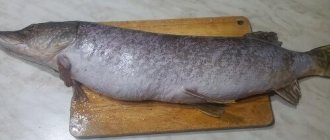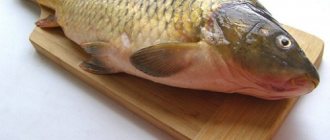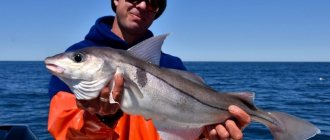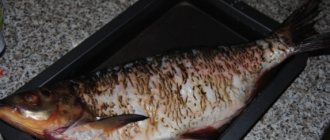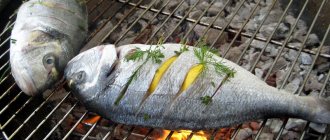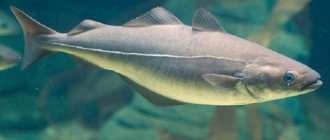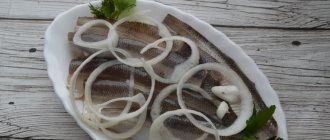Goliath is also called the big tiger fish or the giant hydrocine. This is one of the most unusual freshwater inhabitants with the appearance of a real monster. In Latin, the name translates as “giant water dog,” and it really suits this river fish - it has predatory teeth, large, with sharp, huge fangs. In addition, the goliath fish has a powerful body, large size and... a brutal appetite. What is known about this creature, and is it really so ferocious?
Basic data
Due to its rather decent size, keeping goliath in a home aquarium is impossible. However, any zoo or exhibition hall will not refuse to have such an original specimen in its collection that attracts visitors, and they are often found in such aquariums.
In their natural environment, the length of giant hydrocines reaches one and a half meters, and their weight is 50 kg. And at first glance at this fish it becomes clear - this is not a vegetarian, with such and such teeth! Goliath is an agile, dangerous predator, similar to a piranha, only more impressive in size. Using their powerful jaws and razor-sharp teeth, they are able to rip large chunks of meat from their prey.
Of course, exotic lovers dream of such an extraordinary pet. And the goliath itself may well live in captivity. Only it requires a huge, at least 3000-liter aquarium. It is quite undemanding in maintenance, but, in addition to a spacious tank, it requires a lot of nutritious food.
Difficulty in content
Goliaths definitely cannot be called a fish for a home aquarium; they are kept only in commercial or species aquariums.
In fact, they are not difficult to maintain, but their size and gluttony make them practically inaccessible to amateurs. Although, juveniles can be kept in a regular aquarium, however, they grow very quickly and will then need to be disposed of.
The fact is that in nature the giant hydrocin grows up to 150 cm and can weigh about 50 kg. One look at its teeth and you immediately understand that such a fish does not feed on vegetation.
This is an active and dangerous predator, it is similar to another well-known predator - the piranha, but unlike it, it is much larger. With his huge teeth, he can tear entire pieces of flesh from the body of his victims.
Living in the natural environment
The first description of individuals was compiled in the 60s of the 19th century. Its habitat is African reservoirs, from Egyptian to South African. More often, goliaths are found in Senegal, the Nile, Congo, and Lake Tanganyika. Since hydrocin is a large fish, large, deep rivers and lakes are most suitable for it. Moreover, representatives of this species are not loners and lead a gregarious lifestyle with their brethren or other large predators.
Goliaths are gluttonous, insatiable and successful in hunting. Their diet includes fish, aquatic animals and even crocodiles. There are several recorded cases where they attacked a person, but experts say that the fish behaved this way by mistake, without considering the “prey”.
The goliath is known locally as "mbenga" and is actively fished for. But, in addition to this, they offer this activity as entertainment to numerous tourists. According to fishermen, it is not easy to catch such a large fish, no matter how strong the fishing line is, it still will not withstand such weight. Therefore, the fishing line is replaced with durable steel leads.
Scientists have been interested in these original creatures for a long time; studies have shown that they are contemporaries of dinosaurs. In nature, where hydrocines live, it is difficult to survive, so individuals actively evolved until they turned into dangerous, predatory creatures. Although goliaths have fewer enemies in nature, humans remain the greatest threat to them.
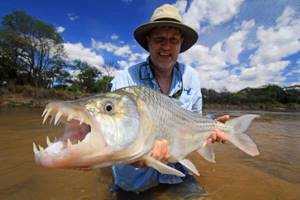
He is engaged in massive catching of this fish, poisoning coastal vegetation with chemicals, polluting the aquatic environment, which leads to a steady decline in the population of giant hydrocines. This state of affairs has attracted the attention of local authorities, environmental services and environmental organizations, who are trying to save such unique river inhabitants from extinction.
Habitat
The large African fish was first mentioned in 1861. Megapiranhas live exclusively in the marine waters of Central Africa. Among the places with the largest numbers of these individuals, there is only one river - the Congo. This river is known for its turbulent and strong current. Not all aquatic life can survive in such a turbulent marine environment. However, the Goliaths feel comfortable. Potential victims, unable to resist the powerful current, unwittingly fall into the mouth of this powerful individual.
For the first time, professional fisherman Jeremy Wade managed to catch a giant goliath specimen. The caught individual weighed 70 kilograms and was 1.5 meters long.
For African fishermen, goliath is the most popular sport fishing object.
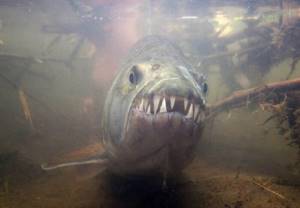
Appearance of individuals
Despite the fact that from the lips of boastful fishermen you can hear about 5-meter-long goliaths caught with your own hands, the size of these river inhabitants is still impressive. For a river inhabitant, one and a half meters in length is already a lot. In captivity, individuals do not grow more than 75 cm. Individuals live from 12 to 15 years. The description of the individuals is as follows:
- the body is oblong, strong;
- fins are small, pointed, orange or reddish in color;
- the head is large, with a wide mouth, equipped with large, sharp teeth - 32 in total;
- With their teeth, fish grab and tear prey without chewing. These fish have teeth replaced by new ones throughout their lives;
- the body is covered with large scales of silver color with a golden tint.
Description
The African big tiger fish can reach a body length of 150 cm and weigh up to 50 kg. Size data constantly varies, but this is understandable; fishermen cannot help but boast.
However, these are record specimens even for nature, and in an aquarium it is much smaller, usually no more than 75 cm. Its lifespan is about 12-15 years.

It has a strong, elongated body with small, pointed fins. The most impressive thing about the appearance of the fish is its head: large, with a very large mouth, with large, sharp teeth, 8 on each jaw.
They serve to grab and tear the victim, and not for chewing, and during life they fall out, but new ones grow in their place.
Diet
In their natural environment, tiger giants most often eat fish and small mammals, although they do not refuse plant food or detritus. With such size and needs, they have to eat a lot often, so goliaths can be called omnivores. When keeping an aquarium, it is recommended that the hydrocin diet consist of the following products and feeds:
- live fish;
- minced meat and fish;
- shrimp;
- fish fillet.
Initially, until the individuals have fully adapted to the new conditions, they feed only on live food. However, later they happily eat frozen food and even artificial food. Young animals do not refuse flakes, but as they grow older, pellets and granular formulations are introduced into their diet.
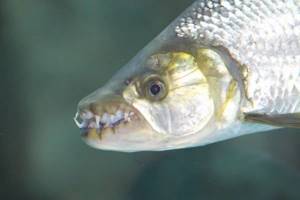
But if pets are constantly given live food in sufficient quantities, they may become more picky and picky, refusing other foods. Therefore, it is recommended to stick to a mixed menu.
Excerpt characterizing the Common tiger fish
Ilya Andreich was a little flushed from the wine and the ride; his eyes, covered with moisture, shone especially, and he, wrapped in a fur coat, sitting on the saddle, had the appearance of a child who was going for a walk. Thin, with drawn-in cheeks, Chekmar, having settled down with his affairs, glanced at the master with whom he lived for 30 years in perfect harmony, and, understanding his pleasant mood, waited for a pleasant conversation. Another third person approached cautiously (apparently he had already learned) from behind the forest and stopped behind the count. The face was that of an old man with a gray beard, wearing a woman's hood and a high cap. It was the jester Nastasya Ivanovna. “Well, Nastasya Ivanovna,” the count said in a whisper, winking at him, “just trample the beast, Danilo will give you the task.” “I myself... have a mustache,” said Nastasya Ivanovna. - Shhh! – the count hissed and turned to Semyon. – Have you seen Natalya Ilyinichna? – he asked Semyon. - Where is she? “He and Pyotr Ilyich got up in the weeds from the Zharovs,” answered Semyon, smiling. - They are also ladies, but they have a great desire. - Are you surprised, Semyon, how she drives... huh? - said the count, if only the man was in time! - How not to be surprised? Boldly, deftly. -Where is Nikolasha? Is it above the Lyadovsky top? – the count kept asking in a whisper. - That's right, sir. They already know where to stand. They know how to drive so subtly that sometimes Danila and I are amazed,” said Semyon, knowing how to please the master. - It drives well, huh? And what about the horse, huh? - Paint a picture! Just the other day, a fox was snatched from the Zavarzinsky weeds. They began to jump over, out of delight, passion - the horse is a thousand rubles, but the rider has no price. Look for such a fine fellow! “Search...,” the count repeated, apparently regretting that Semyon’s speech ended so soon. - Search? - he said, turning away the flaps of his fur coat and taking out a snuff box. “The other day, as Mikhail Sidorich came out from mass in full regalia...” Semyon did not finish, hearing the rut clearly heard in the quiet air with the howling of no more than two or three hounds. He bowed his head, listened and silently threatened the master. “They’ve attacked the brood...” he whispered, and they led him straight to Lyadovskaya. The count, having forgotten to wipe the smile from his face, looked ahead along the lintel into the distance and, without sniffing, held the snuffbox in his hand. Following the barking of the dogs, a voice was heard from the wolf, sent into Danila’s bass horn; the pack joined the first three dogs and the voices of the hounds could be heard roaring loudly, with that special howl that served as a sign of the rutting of the wolf. Those arriving no longer squawked, but hooted, and from behind all the voices came Danila’s voice, sometimes bassy, sometimes piercingly thin. Danila’s voice seemed to fill the entire forest, came out from behind the forest and sounded far into the field. After listening in silence for a few seconds, the count and his stirrup became convinced that the hounds had split into two flocks: one large one, roaring especially hotly, began to move away, the other part of the flock rushed along the forest past the count, and in the presence of this flock Danila’s hooting could be heard. Both of these ruts merged, shimmered, but both moved away. Semyon sighed and bent down to straighten the bundle in which the young male was entangled; The count also sighed and, noticing the snuff-box in his hand, opened it and took out a pinch. "Back!" Semyon shouted at the dog, who stepped out beyond the edge. The Count shuddered and dropped his snuffbox. Nastasya Ivanovna got down and began to lift her.
Aquarium content
All the requirements of goliaths are mainly related to their impressive size:
- several individuals require a tank with a volume of at least 3000 liters;
- filtration is necessary, and the system must be powerful, capable of creating an intense flow - the goliath in nature prefers to live in fast-flowing rivers, and its habit of tearing food into pieces leads to rapid water pollution;
- These are freshwater fish, so there is no need to add salt to the water;
- Large driftwood, stones, sand can be used as decoration;
- You can do without landscaping the aquarium; in addition, hydrocin needs room for swimming.
Keeping in an aquarium
Goliath is a very large and predatory fish, which is obvious. Due to its size and the habit of mature individuals to live in flocks, they require a very large aquarium.
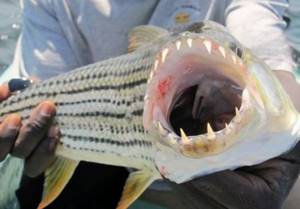
2000-3000 liters is the minimum. Add to this a very powerful filtration and flow system, since the feeding style of tearing the prey to pieces does not contribute to the purity of the water.
In addition, tiger fish live in rivers with strong currents and love the current in the aquarium.
As for the decor, as a rule, everything is done with large driftwood, stones and sand. This fish is somehow not inclined to create green landscapes. And she needs a lot of free space to live.
Getting offspring
It is impossible to breed large tiger fish fry in an aquarium. The bulk of the babies are caught in natural reservoirs and raised. In nature, goliath spawning lasts only a few days during the rainy season. To continue the race, individuals migrate from their usual home to small tributaries, where the female lays a huge number of eggs in small, overgrown areas. When the fry appear, they immediately find themselves in warm water with an abundant food supply, and as they grow older, the current carries them into large bodies of water.
Goliath fish attracts the attention of tourists and zoo visitors. This amazing creature has lived on earth for several million years, has gone through centuries of evolution and can withstand many unfavorable factors... But today it depends on man whether such an extraordinary fish will disappear or continue to exist.
Goliath breeding
Sexual maturity in large tiger fish occurs at 6-7 years of age. During the mating season, males become brighter than females: their pectoral and ventral fins acquire an orange tint. There is practically no mating game: females only slightly tilt their body when the male approaches.
Spawning begins in the morning, at the beginning of spring (March-April), when the water temperature fluctuates between +26...+28°C. Spawning is extended and continues for several months (until mid-June).
The caviar has medium stickiness, which allows the eggs to stick to the rocks of the riffles of large rivers, where the goliath tiger fish, which lives in the channels, spawns. Lake forms spawn in portions at shallow depths (about 10 m), preferring rocky soil at the bottom.
The number of eggs reaches 25-30 thousand. Parents do not care about the offspring, and after spawning they return to a permanent lifestyle.
At a sufficiently high water temperature, incubation of eggs continues for several days (5-10 days). The larvae remain motionless for another 3-5 days, and then begin to swim independently. During this period they feed on plankton. As they grow, they begin to hunt aquatic inhabitants that they can cope with, and weak fry of their species.

